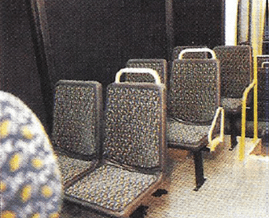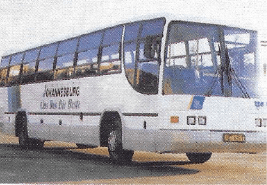- Martin steps in after Boshoff
- Stainless in the Automotive and Transport Industry
- Sassda team summits Kilimanjaro
- SATCA: Tank Containers
- Interfab Looks Ahead
- Going after Orders
- New Age Stainless Steel for Auto Industry
- A New Leader at Stalcor
- Difficult Times for Stainless Suppliers
- First stainless test batch for Iscor
- Campbell sees Exciting Future
3CR12 has been noted as one of the best fabrication materials for use in the coal mining industry in England, being specified for the manufacture of 85 rail cars for National Power.
This represents the first large scale use of 3CR12 in the United Kingdom for this kind of transport.
South Africa has seen 3CR12 rail cars in operation for the last 12 years at Spoornet’s Richards Bay coal line and the world’s largest coal exporting country, Australia, has a large 3CR12 coal car fleet operating on the Queensland and New South Wales export systems.
Passenger trains
While 3CR12 has long established its potential in the transportation of coal in South Africa, Australia, Belgium and the United Kingdom, it is expected to become the first choice fabrication material in the manufacture and refurbishment of passenger trains.
Last year work began on the refurbishment of the Blue Trains, one of South Africa’s primary tourist attractions. The material was selected based upon the economies associated with its ability to withstand wear and tear.
Hundreds of Metro carriages have also been rebuilt with 3CR12, while orders for new passenger coaches for export to Malaysia are in production.
In a similar application, 3CR12 was also used recently as the main body construction material for a revolutionary new light rail vehicle in the United Kingdom – dubbed TRAM.
In both cases, designers achieved a high strength to weight ratio. The use of 3CR12 has halved the weight of the vehicle and TRAM runs on a third of the normal electricity required to power a typical rival continental tram. The super-light vehicle has a top speed way above average.
The 3CR12 safety cage in TRAM ensures that the structure will deform in a controllable manner and absorb sufficient impact energy without intruding into the survival space.
Buses
Experimentation with 3CR12 in road transport began in England in the mid-1980s at Cromweld, Columbus’ overseas marketing arm.
However, Columbus’ general manager, Market Development – and a co-pioneer of 3CR12 – Don Maxwell, emphasises that a great deal of cross-pollination of ideas and technology took place between Cromweld and Columbus.
Bus and coach designs incorporate rigid integral space frames or conventional frame on chassis principles, using square or rectangular section tube and cold rolled formed sections, intended to ensure that, in a crash situation, the structure will deform in a reasonably controllable manner and absorb sufficient impact energy without intruding into the survival space of the passengers.
In South Africa some four hundred 3CR12 buses are on our roads to date, with hundreds more at work throughout the United Kingdom and Europe.
Recently, at the request of major European car, bus and coach manufacturers, Cromweld organised an inspection of an eight year old 3CR12 tubular section. The purpose was to assess internal and external corrosion and fatigue performance.
The vehicle had already covered 1,2 million kilometres and showed that the exposed frame was in extremely good condition. Areas where coating removal had occurred due to stone shipping etc, were clean, with no corrosion effect or underfilm creep.
The vertical pillars, which had not received any internal corrosion protection, were internally inspected and light rusting but no loss of section thickness or pitting was evident.
The frame was also examined above floor level where no external coatings had been used. Again, only superficial surface discoloration was seen.
These results are now being used to confirm long-life structural performance and assist in meeting extended warranty demand throughout Europe.
Cars
Britain’s oldest car manufacturer, AC Cars, believes it has designed a car for life, using 3CR12 stainless steel for the chassis and aluminium for the body panels.
By using 3CR12 for the chassis, the company is able to guarantee the Ace marque’s safety performance for 30 years. The Ace is being positioned as a British competitor to the Mercedes 500 SL. The car is said to be as light as a Porsche and lighter, but more rigid than the Mercedes.
Using stainless steel has enabled the company to use 20 percent less material than if mild steel were used.

Britain’s oldest car manufacturer, AC Cars, believes it has designed a car for life, using 3CR12 utility ferritic stainless steel for the chassis and aluminium for the body panels.
Municipal vehicles
Local authorities are beginning to demand improved performance, reduced downtime and longer vehicle lifetime from their municipal vehicles. This is forcing manufactuters to seek an affordable alternative to mild steel.
In the United Kingdom, an engineering company has specified 3CR12 for its complete range of sweeper vehicles. Ranging in size from compact street washers to huge 17 tonne stand cleaners developed for airports, the vehicles were traditionally subject to corrosion form rock salt and roadside debris.
Cost was a critical consideration in making the decision to use 3CR12 and initially only small sections of the most corroded mild steel parts were replaced with 3CR12. However, the results proved so successful that virtually all the original mild steel components were replaced. 3CR12 has not only been used of the main body of the vehicle, but also for the large volume water tank used for spraying water onto the road.
Because of 3CR12’s exceptional fabrication characteristics, the manufacturer also found the material handled easily, allowing complex shapes to be formed by cutting, machining, perforating, drilling, press brake forming and assembly techniques.
Trailers
Still in the United Kingdom, demand for trailers that combine 304L stainless steel and 3CR12, have been overwhelming.
The Glider Trailer uses 3CR12 for the body and chassis, and 304L stainless steel for the roof rack and smaller parts. Superior corrosion resistance prolongs the life of the trailer – an important factor in coastal regions with harsh weather conditions.
Underground
South of the equator, manufacturers have opted for 3CR12 in the construction of the Galt/PJB Nipper – a personnel carrier or underground bakkie in South African and Australian Mines.
The Nipper is the first vehicle of its kind to be manufactured in the world and is designed as a monocoque constructed vehicle, the construction of which saves valuable space and reduces cost. Without 3CR12, this construction technique would not have been possible.
The project was a joint venture between PJ Berrimann & Co (Pty) Ltd of Australia and its South African counterpart, Galt/PJB (Pty) Ltd. The vehicle is manufactured in Knock down form in Australia and assembled in both countries.
3CR12 was selected because of its corrosion resistant qualities and its ability to withstand the potential damage caused by alkaline salts found in underground mine waters.
In addition the material’s strong structural characteristics make it immune to stress corrosion cracking, a common problem with 316 marine grade stainless steel commonly used underground.






